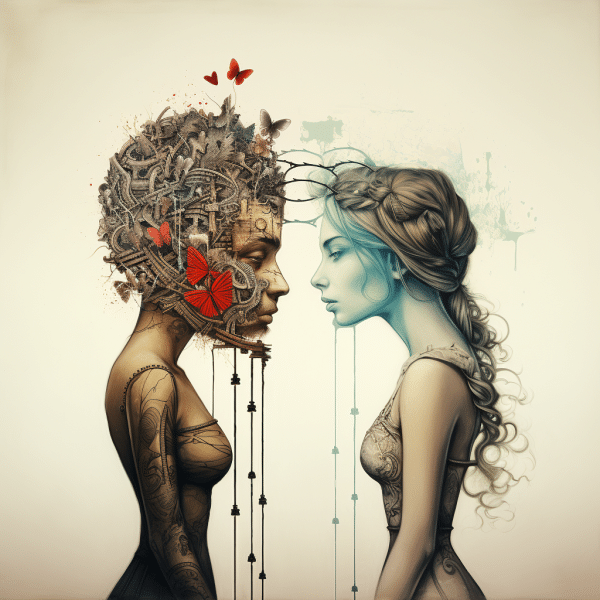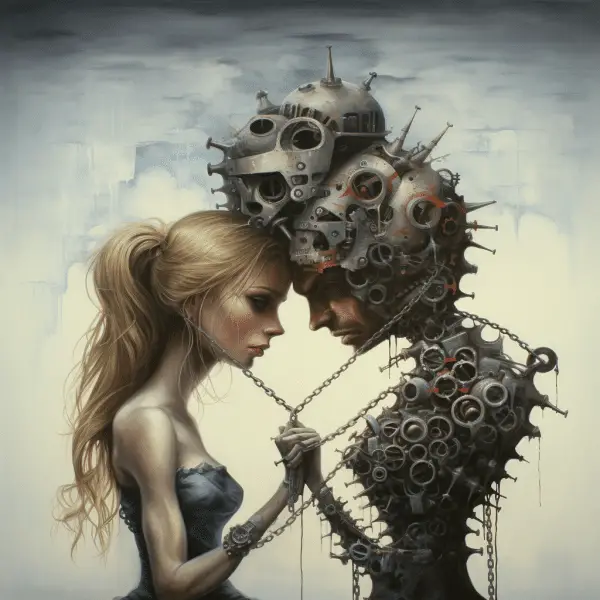
Love and hate relationship
Love and hate have an intriguing connection that has captivated thinkers, psychologists, and creators for ages. Though they appear opposite, they come from an intense bond towards someone or something. Here, we will investigate the intricate relationship between love and hate and analyze the components that work together.
Love is usually perceived as a positive feeling loaded with fondness, kindness, and understanding for another person or thing. It includes emotions such as enthusiasm, closeness, and loyalty. On the contrary, hate is normally viewed as a negative emotion showing extreme dislike or enmity for someone or something. Despite being completely different, these two feelings are close-knit in ways that are not obvious.
One factor in the link between love and hate is the intensity of emotions involved. Love can be passionate and overpowering, making people put a lot of emotional energy into their relationships. If these sentiments are betrayed or unreciprocated, love can become hatred due to distress, fury, or being let down. Also, hate can originate from hidden feelings of love that have been distorted or quashed.
Plus, love and hate are often caused by similar psychological processes. Both emotions may derive from a feeling of dependence on others. The dread of losing someone we care about deeply can bring about extreme feelings which can be love or hate. Also, love and hate can have common origins such as envy or indignation.
Realizing the complex relationship between love and hate can give us knowledge about human behavior and relationships. Knowing that these emotions often exist within us allows us to deal with our relationships with more empathy and sympathy.
To create more loving relationships while minimizing the potential for hate to emerge, here are a few ideas that might prove useful:
- Develop open communication: A lack of clear communication can lead to disputes and rancor, causing hate to surface. By establishing open and honest conversations, we can address matters before they get out of hand.
- Apply empathy: Empathy lets us comprehend and relate to others’ experiences and feelings, which leads to connection and reduces the possibility of negative feelings such as hate taking place.
- Accept forgiveness: Forgiveness is a powerful tool in stopping the cycle of love turning into hate. Giving up past grievances helps healing and opens up the path for better relationships.
- Enhance self-awareness: Knowing our own emotions, desires, and triggers can aid us in managing our reactions better and stop love from turning into hate too soon.
By following these tips, individuals can better manage the sensitive balance between love and hate, building stronger ties while keeping the potential for negative feelings at bay.
Explaining the concepts of love and hate
To understand the concepts of love and hate, delve into their definitions. Define love to grasp its essence, and define hate to comprehend its nature. These sub-sections will provide a concise exploration of the two concepts, allowing you to gain a deeper understanding of their relationship.
Sub-heading: Defining love
Love is a complex emotion that surpasses words. It’s an affectionate bond and attachment to someone or something. It’s selfless, compassionate, and always seeks the joy and welfare of the beloved. Love goes beyond physical attraction and is based on trust, respect, and support.
It isn’t just human connections; love is also found in nature, art, and even abstract ideas like freedom. It brings people together, connecting different backgrounds, cultures, and beliefs. Kindness, devotion, empathy, and sacrifice are all expressions of love. It makes us care for others without expecting anything in return.
Love is depicted in many forms of literature, art, music, and film. Stories about how love triumphs over obstacles and changes lives have been around for ages – from Shakespeare’s Romeo & Juliet to classic love songs. Love is a powerful emotion that captivates our hearts.
Sub-heading: Defining hate
Defining hate is complex. It’s an intricate web of emotions that’s hard to untangle. Hate is shown in many forms, from anger to resentment. It is an extremely negative emotion, often rooted in a feeling of unfairness.
At its centre, hate means disliking someone or something intensely. It goes beyond mere displeasure or irritation. Hate is distinguished by a strong urge to cause harm or hurt, both mentally and physically. It can take over people and push them to do terrible things.
An interesting thing about hate is that it can spread like a virus. It can easily spread throughout communities and societies, contaminating the minds of many. This makes it even more crucial to tackle hate as soon as it appears.
Hate isn’t inborn; it’s taught. Kids aren’t born hating, but they learn it through influential elements like family, society and life experiences. Knowing this emphasizes the importance of education and understanding in fighting hatred.
The Journal of Experimental Psychology carried out a study, which showed that hate has damaging consequences for wellbeing – both mental and physical. It found that people with deep-seated hate have higher levels of stress and anxiety, increasing their chances of getting ill.
Exploring the connection between love and hate
To better understand the relationship between love and hate, delve into the section that explores their connection. Uncover the similarities between love and hate, as well as the differences. Discover how these two seemingly opposing emotions can intertwine and coexist, shedding light on the complexity of human emotions.
Sub-heading: Similarities between love and hate
Love and hate are two powerful emotions that appear to be on opposite ends. But, when we take a closer look, similarities between the two become clear. Knowing these can help us grasp the complexity of human feelings.
Love and hate both originate from strong connections. They can be relationships or loyalty towards someone. They can take over a person’s thoughts, actions, and decisions, leaving no space for anything else. Often, they do not make sense, leading people to act in ways that others can’t understand. Love and hate can both transform people and shape their identity. Sometimes people feel both love and hate for someone at the same time, making the difference between them hard to spot.
Studying this topic further reveals many stories from the past, where love changed to hate or the other way round. One of them is between Cleopatra and Julius Caesar. Cleopatra was in love with him and saw him as her protector. But when he was killed, her love changed to intense hatred for his murderers. This demonstrates how fast the line between these two emotions can blur.
Sub-heading: Intense emotions
Passionate emotions have captivated humans for centuries. Love and hate are no exception. Though seemingly opposite, these two powerful emotions often intertwine and leave us feeling confused.
Love and hate have the same root – passion. Both emotions stem from strong feelings for something or someone. Love is seen as a positive emotion, whereas hate is its darker side. However, the intensity they bring is undeniable.
When we love intensely, boundaries become blurred. This intensity can pave the way for hatred to form. The line between the two emotions is even more blurred when we realize that love can be expressed through acts of hatred.
It is intriguing to see how these emotions can coexist and fuel each other. Love can be transformed into hate due to betrayal or loss, but it can also emerge from hate through forgiveness. This complex relationship challenges our view of emotions as separate entities and reminds us of human complexity.
According to research by Dr. Levenson et al., from the University of California-Berkeley, it was found that the emotional responses triggered by both love and hate are similar at a physiological level. This suggests that despite their different outward manifestations, these intense emotions may be more connected than previously thought.
Sub-heading: Deep attachment
Deep attachment is an intricate connection that binds two people together. It goes beyond mere fondness, delving into a realm of intense emotional bonding. This attachment is often characterized by loyalty and a sense of belonging.
Let’s explore the concept further through a table:
| Features | Description |
|---|---|
| Emotional | Strong emotional bonds between individuals are the core of deep attachment. Intimacy, compassion, and understanding are cultivated. |
| Commitment | This attachment requires commitment and dedication to the relationship or connection. |
| Trust | Trust is essential for fostering a secure bond. |
| Shared Values | Shared values create a foundation for the attachment, as both individuals find common ground. |
Besides these features, mutual support, reciprocated care, and willingness to face life’s challenges together are also part of deep attachment.
Deep attachment can be found in romantic relationships, friendships, family bonds, and professional connections. Depending on the relationship, the strength of the attachment may vary.
We can find examples of deep attachment throughout literature and art. Romeo and Juliet’s love story and Sherlock Holmes and Dr. John Watson’s friendship demonstrate the intensity of this attachment.
Sub-heading: Differences between love and hate
Love and hate are complex emotions that can seem similar, but they’re really very different. Love involves affection, care, and looking out for the loved one. Hate brings intense hostility and a wish for harm. Knowing the difference between these two powerful feelings can help us understand human psychology better.
Here’s how love and hate differ:
| Love | Hate |
|---|---|
| Affectionate | Hostile |
| Care | Animosity |
| Desire for well-being | Wish for harm |
It’s important to note that an individual can feel both love and hate. This complexity reveals how complex human emotions and relationships are.
Also, love and hate have different impacts on people and society. Love creates understanding, empathy, and connection among people, bringing harmony. Hate causes division, aggression, and prejudice, sometimes even violence.
Stanford University psychologists did research that found that love can boost well-being and reduce stress. On the other hand, studies suggest that prolonged hatred causes mental health problems and more aggression.
Remember: Love triumphs over hatred!
Sub-heading: Positive vs. negative emotions
Positive and negative emotions have a huge role in how we view the world. Our emotions shape our life, thinking, actions, and relationships. To get a better understanding of positive and negative emotions is essential to developing our behaviour and wellbeing.
- Happy feelings such as joy, love and contentment help us to be content and joyful. They give us the resilience to cope with stress and improve our mental health.
- Negative emotions such as fear, anger and sadness can be damaging to our mental health if not managed correctly. It’s important to be aware of these feelings, but also find a healthy way to address them.
- Positive emotions have been linked to better physical health outcomes, including reduced risk of cardiovascular disease, boosted immune system and increased life expectancy.
- Negative emotions can cause several health issues such as high blood pressure, weak immune system and increased vulnerability to chronic diseases.
- Positive emotions create social relationships through empathy, compassion and cooperation. This helps to build strong relationships based on trust and support.
- Negative emotions can have a negative effect on our relationships if expressed incorrectly. Nevertheless, they can be a catalyst for change or motivate us to resolve underlying issues.
positive emotions
Although positive emotions are usually preferred over negative ones because of their benefits to our mental and physical health, it is important to remember that both types of emotions happen in life. Recognizing all emotions allows us to have a more genuine experience.
Throughout history, both love and hate are present in human experiences. A great example is Romeo and Juliet’s story – their passionate love turns into hatred when their families are enemies. This serves as a reminder that even the strongest feelings can quickly switch from positive to negative in certain situations.
In conclusion, grasping the connection between positive and negative emotions helps us to manage life’s highs and lows. It reminds us to take care of our emotional wellness and to foster positive emotions while acknowledging and addressing negative ones healthily.
Sub-heading: Altruism vs. aggression
Altruism and aggression – two forces at play. Altruism is an act of love, stemming from compassion and empathy. Aggression, however, is spewed from negative emotions like envy, resentment, and the desire for power.
The balance between love and hate is delicate. Knowing and understanding this helps navigate conflicts with tact while promoting empathy.
Altruism strengthens relationships. It fosters trust and mutual support. Aggression, on the other hand, erodes it. Bringing discord and conflict in societies.
Societies that prioritize altruism thrive. Their members have cooperation and harmony. While aggression leads to social disarray.
To establish a healthier connection with ourselves and others, we must focus on cultivating empathy over hostility. Active listening can help nurture altruistic tendencies by fostering deeper understanding.
Psychological perspectives on the relationship between love and hate
To gain insights into psychological perspectives on the relationship between love and hate, dive into the contrasting theories of Freudian and cognitive dissonance. Explore how Freudian theory analyzes the complexities of love and hate, while cognitive dissonance theory sheds light on the psychological conflicts that arise from these emotions.
Sub-heading: Freudian theory
Freudian theory delves into the complex interplay between love and hate in the human psyche. He claims love is driven by the Eros instinct—a force that promotes unity and life. Hate arises from the Thanatos instinct—one that seeks destruction. But these opposing instincts coexist within us.
He examines the unconscious mind and childhood experiences to uncover the roots of love and hate. Freud also speaks of transference—the unconscious redirection of emotions. This explains why we may feel intense emotions towards someone that reminds us of someone we once loved or hated.
Understanding Freud’s perspective can help us comprehend our own subconscious motivations and relationships. We gain a deeper understanding of the complexities within ourselves and our relationships by recognizing how love and hate can be intertwined at a deep psychological level.
Sub-heading: Cognitive dissonance theory
Cognitive dissonance theory provides a captivating look at how love and hate intertwine. It suggests that clashing emotions towards someone, such as a romantic partner, create psychological discomfort. This turmoil results from the inconsistency between positive and negative feelings. To reduce this dissonance, people try to reconcile the conflicting emotions or justify their ambivalence.
Diving deeper into this concept reveals much about the relationship between love and hate. It demonstrates how we can be stuck in a mental battle, struggling with conflicting thoughts and feelings. The theory also reveals coping mechanisms, like concentrating on the positive aspects or downplaying negative experiences. This shows how humans can modify perception and emotion when dealing with both love and hate.
Cognitive dissonance theory offers insight into the coexistence of love and hate within human relationships. Realizing the tension that this paradox brings can help us work on reconciling opposing emotions. It can help us achieve internal harmony and cultivate healthier attachments.
Moreover, acknowledging this complexity provides us with personal growth opportunities. It encourages self-awareness, sympathy, and understanding. Understanding cognitive dissonance theory requires us to face challenging contradictions instead of avoiding them. Doing so unlocks more personal and interpersonal fulfillment. Let us embrace the complexity of love and hate to open up greater possibilities.
The impact of love-hate relationships on individuals and society
To understand the impact of love-hate relationships on individuals and society, delve into the emotional rollercoaster, complex dynamics in relationships, and societal implications and conflicts. Explore how these sub-sections shed light on the intricate connections between love and hate, revealing the profound effects they have on our lives and the world around us.
Sub-heading: Emotional rollercoaster
The Emotional Rollercoaster of Love-Hate Relationships
Love-hate relationships have always been known for their tumultuous nature. Constant fluctuations between affection and animosity can have a powerful effect on both individuals and society.
This rollercoaster takes you on a wild ride. One moment, you’re feeling passionate and adoring. The next, waves of anger and resentment crash down. This oscillation can cause anxiety, confusion, and instability.
The effects of these rollercoaster relationships don’t just affect the couple. They can affect work, school, friendships, and social dynamics. It’s a ripple effect that goes far beyond the couple.
Love-hate relationships have an addictive quality. The highs of love and lows of hatred can become strangely alluring. This can trap people in a toxic cycle, making it hard to find happiness or healthier connections.
Pro Tip: Recognize the patterns. Seek therapy or counseling for insight and support. Navigate this rollercoaster and create healthier relationship dynamics.
Sub-heading: Complex dynamics in relationships
The intricate web of love and hate in relationships can have a big effect on people and society. Positive feelings like affection, admiration, and closeness blend with negative emotions like anger, frustration, and resentment.
These dynamics can create excitement and passion, but can also be draining. They can also cause conflicts outside the relationship, in communities or even whole societies.
To deal with this complexity, people need to develop strong emotional intelligence. This includes being aware of own and others’ emotions and expressing them without causing harm. It also involves empathy, understanding perspectives, and listening.
Lastly, self-awareness helps individuals recognize their own behavior that leads to the love-hate dynamic and allows for personal growth. Therapy or advice from professionals can provide tools to manage and transform these relationships.
Sub-heading: Societal implications and conflicts
The societal implications and conflicts caused by love-hate relationships can have deep consequences for individuals and communities. For instance, disruption of social harmony, increased aggression and violence, mental health deterioration, and strained relationships. Further, these relationships can tear societies apart, creating an atmosphere of tension and conflict. This could lead to alienation and mistrust between people and communities.
Love-hate relationships involve a complex mix of emotions. This can cause stress, anxiety, and depression for those involved. This ultimately affects the mental health of society. To counter this, some steps can be taken. For example, promoting communication and dialogue, investing in mental health services, and educating people on emotional intelligence. These can help individuals cultivate healthier relationships based on respect, understanding, and empathy.

Conclusion
Love and hate: a complex relationship. Apparent contradictions, yet intertwined in various ways. Love can become hate, and hate can come from strong love or passion. Uncovering this connection lets us glimpse human behavior and relationships.
Love and hate both come from within us. Deep emotions that can be provoked by the same triggers: betrayal, disappointment, unmet expectations. The distinction between these two is tricky, as love can swiftly change to hatred under certain conditions.
Love and hate are not opposites; they can exist together in one person, or in a relationship. This complexity brings out the intricacies of human emotions and the strength of our feelings towards others. People often have conflicting emotions at the same time, or switch between intense love and intense hatred.
The intensity of love and hate reveals their influence over us. Positive or negative, they can drive us to do great things. Love motivates kindness, selflessness, and sacrifices, while hate provokes violence, retribution, and destruction. Knowing this duality gives us insight into human behavior.
Fostering self-awareness and emotional intelligence helps us manage the relationship between love and hate. Knowing our feelings towards others enables us to approach relationships with greater empathy. Plus, learning healthy ways to cope with negative emotions prevents them from becoming hate.
Open communication in relationships resolves conflicts created by love-hate dynamics. Expressing thoughts and feelings honestly and respectfully allows us to sort out misunderstandings before resentment takes root.
To understand the complexities of love and hate, we must explore our own emotions and human nature. Acknowledging their coexistence and interplay provides valuable knowledge of our own behavior and relationships with others. Loving while managing and reducing hate leads to healthier and more fulfilling connections.
Frequently Asked Questions
Q: What is the relationship between love and hate?
A: The relationship between love and hate is complex and often intertwined. Both emotions are intense and passionate, but they exist on opposite ends of the emotional spectrum.
Q: Can love and hate coexist?
A: Yes, love and hate can coexist. Sometimes, people can experience love and hate for the same person or thing simultaneously. This can be due to a deep emotional connection or conflicting feelings.
Q: How are love and hate similar?
A: Love and hate share similarities in terms of the intensity of emotions they evoke. Both emotions can consume a person’s thoughts and actions, leading to strong feelings and sometimes irrational behaviors.
Q: How are love and hate different?
A: Love and hate differ in their underlying emotions and intentions. Love is fueled by affection, care, and a desire for connection, while hate stems from anger, resentment, and a desire to harm or distance oneself from the subject of hatred.
Q: Can love turn into hate?
A: Yes, love can turn into hate under certain circumstances. Betrayal, disappointment, or a perceived threat to one’s well-being can lead to a shift in emotions and the development of hatred towards someone or something that was previously loved.
Q: Can hate turn into love?
A: It is less common for hate to turn into love, but it is possible in some cases. Over time, with perspective and personal growth, negative feelings can fade, forgiveness can be attained, and love can be rekindled.









